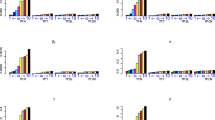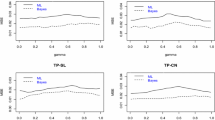Abstract
In this paper, we provide an extension for partially linear models (PLMs) to allow the errors to follow a flexible class of two-piece distributions based on the scale mixtures of normal (TP-SMN) family. The TP-SMN is a rich class of distributions that covers symmetric/asymmetric as well as lightly/heavily tailed distributions which can be used to model datasets with outlying and also atypical data. Using a suitable hierarchical representation of the TP-SMN family developed specifically for PLM, we derived an EM-type algorithm for iteratively computing maximum penalized likelihood estimates of the proposed model parameters. We examined the performance of the proposed PLM model and methodology using simulation studies and a real dataset to show the robust aspects of this model.





Similar content being viewed by others
References
Härdle W, Müller M, Sperlich S, Werwatz A (2004) Nonparametric and semiparametric models. Springer, Berlin
Hastie T, Tibshirani R (1990) Generalized additive models. Chapman and Hall, London
Howard LA, Levetin E (2014) Ambrosia pollen in tulsa, oklahoma: aerobiology, trends, and forecasting model development. Ann Allergy Asthma Immunol 113:641–646
Ibacache-Púlgar G, Paula GA (2011) Local influence for student-t partially linear models. Comput Stat Data Anal 55:1462–1478
Lachos VH, Bolfarine H, Arellano-Valle RB, Montenegro LC (2007) Likelihood based inference for multivariate skew-normal regression models. Commun Stat Theory Methods 36:1769–1786
Relvas CEM, Paula GA (2016) Partially linear models with first-order autoregressive symmetric errors. Stat Pap 57:795–825
Ruppert D, Wand MP, Carrol R (2003) Semiparametric regression. Cambridge University Press, New York
Ferreira CS, Paula GA (2016) Estimation and diagnostic for skew-normal partially linear models. J Appl Stat. https://doi.org/10.1080/02664763.2016.1267124
Ferreira CS, Zeller CB, Mimura AMS, Silva JCJ (2016) Partially linear models and their applications to change point detection of chemical process data. J Appl Stat. https://doi.org/10.1080/02664763.2016.1247788
Maleki M, Mahmoudi MR (2017) Two-piece location-scale distributions based on scale mixtures of normal family. Commun Stat Theory Methods 46(24):12356–12369
Moravveji B, Khodadadi Z, Maleki M (2019) A Bayesian analysis of two-piece distributions based on the scale mixtures of normal family. Iran J Sci Technol Trans A Sci 43(3):991–1001
Arellano-Valle RB, Gómez H, Quintana FA (2005) Statistical inference for a general class of asymmetric distributions. J Stat Plan Inference 128:427–443
Maleki M, Nematollahi AR (2017) Bayesian approach to epsilon-skew-normal family. Commun Stat Theory Methods 46(15):7546–7561
Maleki M, Barkhordar Z, Khodadado Z, Wraith D (2019) A robust class of homoscedastic nonlinear regression models. J Stat Comput Simul 89(14):2765–2781
Hoseinzadeh A, Maleki M, Khodadadi Z (2020) Heteroscedastic nonlinear regression models using asymmetric and heavy tailed two-piece distributions. AStA Adv Stat Anal. https://doi.org/10.1007/s10182-020-00384-3
Barkhordar Z, Maleki M, Khodadadi Z, Wraith D, Negahdari F (2020) A Bayesian approach on the two-piece scale mixtures of normal homoscedastic nonlinear regression models. J Appl Stat. https://doi.org/10.1080/02664763.2020.1854203
Ghasami S, Khodadadi Z, Maleki M (2020) Leptokurtic and platykurtic class of robust symmetrical and asymmetrical time series models. J Comput Appl Math. https://doi.org/10.1016/j.cam.2020.112806
Maleki M, Mahmoudi MR, Heydari MH, Pho KH (2020a) Modeling and forecasting the spread and death rate of coronavirus (COVID-19) in the world using time series models. Chaos Solitons Fractals. https://doi.org/10.1016/j.chaos.2020.110151
Maleki M, Mahmoudi MR, Wraith D, Pho KH (2020b) Time series modelling to forecast the confirmed and recovered cases of COVID-19. Travel Med Infect Dis. https://doi.org/10.1016/j.tmaid.2020.101742
Andrews DR, Mallows CL (1974) Scale mixture of normal distribution. J R Stat Soc B 36:99–102
Green PJ (1987) Penalized likelihood for general semi-parametric regression models. Int Stat Rev 55:245–259
Green PJ, Silverman BW (1994) Nonparametric regression and generalized linear models: a roughness penalty approach. Chapman and Hall, Boca Raton
Dempster AP, Laird NM, Rubin DB (1977) Maximum likelihood from incomplete data via the EM algorithm. J R Stat Soc Ser B Methodol 39:1–22
McLachlan GJ, Peel D (2000) Finite mixture models. Wiley, New York
Liu C, Rubin DB (1994) The ECME algorithm: a simple extension of EM and ECM with faster monotone convergence. Biometrika 81:633–648
Meng X, Rubin DB (1993) Maximum likelihood estimation via the ECM algorithm: a general framework. Biometrika 80:267–278
R Core Team (2021) R: a language and environment for statistical computing. R Foundation for Statistical Computing, Vienna, Austria. https://www.R-project.org/
Akaike H (1974) A new look at the statistical model identification. IEEE Trans Autom Control 19:716–723
Eilers PHC, Marx BD (1996) Flexible smoothing with B-splines and penalties. Stat Sci 11:89–121
Louis TA (1982) Finding the observed information using the EM algorithm. J R Stat Soci Ser B (stat Methodol) 44:226–233
Meilijson I (1989) A fast improvement to the em algorithm to its own terms. J R Stat Soc Ser B (stat Methodol) 51:127–138
Mark RS, Bacchetti P, Jewell NP (1994) Variances for maximum penalized likelihood estimates obtained via the em algorithm. J R Stat Soc Ser B (methodol) 56(2):345–352
Efron B, Tibshirani R (1993) An introduction to the bootstrap. Chapman & Hall/CRC, Boca Raton. ISBN 0-412-04231-2
Branco MD, Dey DK (2001) A general class of multivariate skew-elliptical distributions. J Multivar Anal 79:99–113
Hajrajabi A, Maleki M (2019) Nonlinear semiparametric autoregressive model with finite mixtures of scale mixtures of skew normal innovations. J Appl Stat 46(11):2010–2029
Author information
Authors and Affiliations
Contributions
MB: data curation, validation, writing—original draft. KZ: conceptualization, writing, software, supervision. MM: investigation, methodology, software, review & editing. ZK: visualization, review and editing.
Corresponding author
Ethics declarations
Conflict of interest
The authors declare that they have no conflict of interest.
Additional information
Publisher's Note
Springer Nature remains neutral with regard to jurisdictional claims in published maps and institutional affiliations.
Rights and permissions
About this article
Cite this article
Bazrafkan, M., Zare, K., Maleki, M. et al. Partially linear models based on heavy-tailed and asymmetrical distributions. Stoch Environ Res Risk Assess 36, 1243–1253 (2022). https://doi.org/10.1007/s00477-021-02101-1
Accepted:
Published:
Issue Date:
DOI: https://doi.org/10.1007/s00477-021-02101-1




